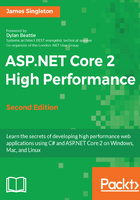
Foreword
cancellation of the steady and staggering gains made by the computer hardware industry."
We live in the age of distributed systems. Computers have shrunk from room-sized industrial mainframes to embedded devices that are smaller than a thumbnail. However, at the same time, the software applications that we build, maintain, and use every day have grown beyond measure. We create distributed applications that run on clusters of virtual machines scattered all over the world, and billions of people rely on these systems, such as email, chat, social networks, productivity applications, and banking, every day. We're online 24 hours a day, seven days a week, and we're hooked on instant gratification. A generation ago, we'd happily wait until after the weekend for a cheque to clear, or allow 28 days for delivery. Today, we expect instant feedback, and why shouldn't we? The modern web is real-time, immediate, on-demand, and built on packets of data flashing around the world at the speed of light, and when it isn't, we notice. We've all had that sinking feeling... you know, when you've just put your credit card number into a page to buy some expensive concert tickets, and the site takes just a little too long to respond. Performance and responsiveness are a fundamental part of delivering a great user experience in the distributed age. However, for a working developer trying to ship your next feature on time, performance is often one of the most challenging requirements. How do you find the bottlenecks in your application performance? How do you measure the impact of those problems? How do you analyze them, design and test solutions and workarounds, and monitor them in production so that you can be confident that they won't happen again? This book has the answers. Inside, James Singleton presents a pragmatic, in-depth, and balanced discussion of modern performance optimization techniques, and how to apply them to your .NET and web applications. Starting from the premise that we should treat performance as a core feature of our systems, James shows how you can use profiling tools such as Glimpse, MiniProfiler, Fiddler, and Wireshark to track down the bottlenecks and bugs that cause your performance problems. He addresses the scientific principles behind effective performance tuning, monitoring, instrumentation, and the importance of using accurate and repeatable measurements when you make changes to a running system to try and improve performance.
This book goes on to discuss almost every aspect of modern application development: database tuning, hardware optimisations, compression algorithms, network protocols, and object-relational mappers. For each topic, James describes the symptoms of common performance problems, identifies the underlying causes of those symptoms, and then describes the patterns and tools that you can use to measure and fix these underlying causes in your own applications. There's an in-depth discussion of high-performance software patterns such as asynchronous methods and message queues, accompanied by real-world examples showing you how to implement these patterns in the latest versions of the .NET framework. Finally, James shows how you can not only load test your applications as a part of your release pipeline, but you can continuously monitor and measure your systems in production, letting you find and fix potential problems long before they start upsetting your end users.
When I worked with James here at Spotlight, he consistently demonstrated a remarkable breadth of knowledge, from ASP.NET to Arduinos and from Resharper to resistors. One day, he'd build reactive frontend interfaces in ASP.NET and JavaScript; the next day, he'd create build monitors by wiring microcontrollers into Star Wars toys, or working out how to connect the bathroom door lock to the intranet so that our bicycling employees could see from their desks when the office shower was free. After James moved on from Spotlight, I've been following his work with Cleanweb and Computing 4 Kids Education. He's one of those rare developers who really understands the social and environmental implications of technology; whether it's delivering great user interactions or just saving electricity, improving your systems' performance is a great way to delight your users. With this book, James has distilled years of hands-on lessons and experience into a truly excellent all-round reference for .NET developers who want to understand how to build responsive and scalable applications. It's a great resource for new developers who want to develop a holistic understanding of application performance, but the coverage of cutting-edge techniques and patterns means it's also ideal for more experienced developers who want to make sure they're not getting left behind. Buy it, read it, share it with your team, and let's make the web a better place.
Dylan Beattie
Systems architect REST evangelist, technical speaker
Co-organizer of the London .NET User Group